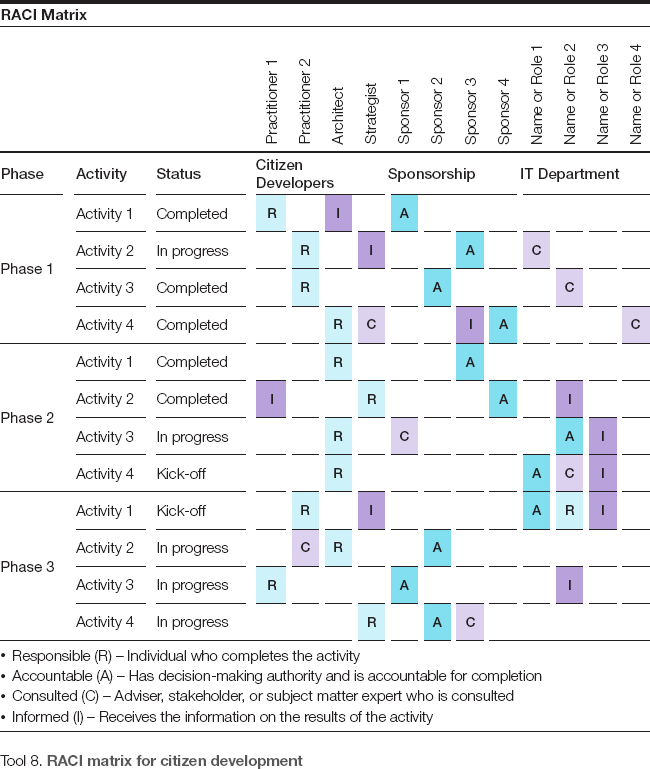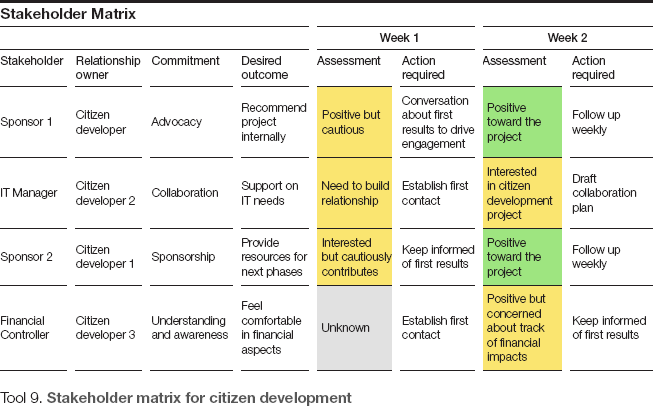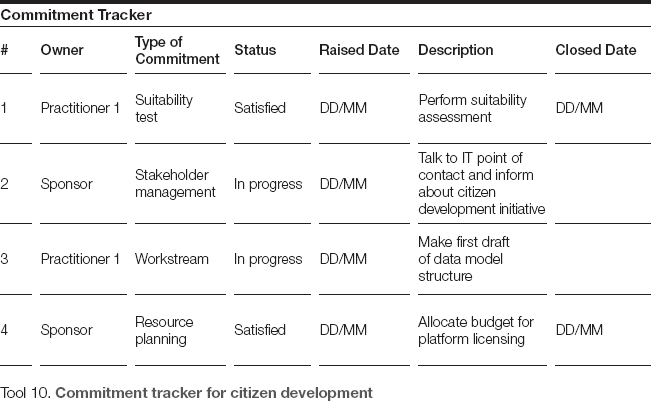| 5.3 Transparent Accountability |  |
Accountability lies at the heart of performance.
Driving accountability is a key management skill. Instilling accountability through devolved decision making is a key enabler to empower citizen development.
In this section you will find:
•What accountability means and its importance in fostering citizen development
•The basics of commitment-based management
•Guidance on how to use accountability tools, such as the RACI matrix, the stakeholder matrix, and the commitment tracker

Overview
Creating a culture of accountability is increasingly recognized as important in business today. Accountability lies at the heart of performance. Determining who is accountable for what and holding individuals and teams accountable is becoming a key management skill for effective strategic implementation. Driving accountability into the operating model is critical to scale citizen development. In order to be effective, the approach involves top-down commitment, starting with the C-suite. In this section, we will outline the importance of holding stakeholders in the operating model accountable, and its impact on performance. We will provide some tools and approaches for managing accountability across the organization.
Top-down direction setting and commitment are required to help align and manage multiple stakeholders across the organization. Often competing influences or lack of transparency can mean that stakeholders do not deliver on their element of the project, so effectively managing accountability is a way of mitigating this.
Transparent Accountability in Practice
What do we mean by accountability and why is it important?
Accountability involves taking ownership for outcomes and decisions that lead to a certain outcome. To be accountable, you need to have the authority to make decisions that lead to certain outcomes. Instilling accountability through devolved decision making is a key enabler of empowerment and a necessary condition to scale citizen development. Having accountability in citizen development brings transparency, clarity, and alignment between an organization's objectives and the individual's objectives.
| DID YOU KNOW? |
The American Society of Training and Development (ASTD) study on accountability found that you have a 65% better chance of completing a goal if you commit to someone (Hanke, 2018).
Citizen development will only work if business leaders and line managers are committed to empowering citizen developers to resolve the problems around them. In turn, citizen developers who have been given additional freedoms to experiment and solve these problems will need to take on the additional related responsibilities, such as designing solutions that are acceptable to IT standards and supporting the needs of their colleagues. Many of these considerations are covered in Parts 2 and 3.
| MARKET RESEARCH |
To foster accountability in the people around you, you need to aim for clarity in five areas (Bregman, 2016):
1. Clear expectations
2. Clear capabilities
3. Clear measurement
4. Clear feedback
5. Clear consequences
Fostering a culture of transparency and accountability
As accountability gets embedded into the organization, citizen developers will want greater transparency around them. This creates the need to have clear roles and responsibilities for the people involved in citizen development and IT. Therefore, citizen developers will be recognized and rewarded for their successes, and will not be blamed for actions they have nothing to do with. One way to achieve this is by growing visibility around the citizen development process and by nurturing innovations and experiments. This means that citizen developers must also be allowed to fail and learn. Basically, business leaders and their managers should embrace all citizen development principles, not just transparency. This means that organizations should create visibility about successes and failures and what has been learned from all of these experiences.
Commitment-based management
Commitment-based management is a set of management practices that focuses on linguistics—concise and clear communication—where the use of words that have a specific meaning is a powerful way to drive accountability. A commitment is a promise made by one person (a performer) to another (a customer) to agree to deliver an outcome by a specified date. The relationship between the customer and performer can be a peer-based line manager to a subordinate or a subordinate to a line manager. This structure brings clarity, drives accountability, and is outcome focused. The conversation where requests occur, commitments are made, and feedback is provided is where work happens.
In organizations that have adopted commitment-based management, the traditional hierarchical structures are replaced by requests and commitments flowing across an organization's boundaries. While governance is required, this style of working is very suited to citizen development. It supports devolved decision making, creates the opportunity for improved collaboration, and results in radical transparency and improved productivity. This typically characterizes an agile organization.
When implemented well, commitment-based management flattens the inherent authority that comes with hierarchical organizations. Citizen development flourishes in an environment where the citizen developer holds their customer (the person who will benefit from the outcomes delivered) equally accountable. This is achieved through a structured set of conversations that start with the request and end with the customer stating whether they are satisfied or not. The citizen developer may look to the customer to provide the tools, advice, guidance, and resources (financial or staff) necessary to ensure the initiative can be completed satisfactorily. This creates collaboration when structured well, and builds trust between the citizen developer and their customers.
Tools to manage accountability
For every part of an organization, there has to be a layer of governance and accountability to drive results while creating a sense of ownership for citizen development. This is of key importance when managing accountability at the right stage in the organization.
The more mature a citizen development program is in an organization, the more important accountability becomes, as the citizen developers are empowered to make decisions.
At the early stages, accountability and governance need to be catalysts rather than inhibitors. That is, if governance is too strong too early on, it will put out the fire. When done correctly, accountability and governance can be the oxygen that will help the fire grow. It is key to maintaining a balance between fostering citizen development and maintaining control of the initiatives. With regard to citizen development, governance and accountability grow in line with the maturity of the organization; don't expect it all to be figured out from day one.
Having good practices in place during the different phases of maturity is key, but they can be developed, extended, and completed along the way. So yes, you can use a matrix to define the people who are responsible and accountable in an early stage, just be sure not to aim for completion too early. Start with registering agreements, then documenting them, followed by formalization in a later stage. Allow the tools to evolve as the organization evolves.
To enhance accountability in the later stages, there are several tools that managers can use such as the RACI matrix, stakeholder matrix, or commitment tracker.
The RACI matrix will help citizen developers assess, for any given action, who is responsible, who is accountable, who should be consulted, and who should be informed (see Tool 8). Ideally, there should be only one responsible person and one accountable person for each activity. When an activity requires several responsible and accountable people, it is key that each of them has a clear view of their responsibilities and accountabilities. However, there can be several people consulted and informed.

While the RACI matrix offers a useful overview of the stakeholders and their responsibilities throughout the project, it does not provide any detail on how to manage them. For that purpose, citizen developers should make use of the stakeholder matrix (see Tool 9).
Using colors on the assessment columns will help to visually identify the stakeholders who need more attention. Try to use the green color only when the stakeholder attitude is close to the desired outcome.

Examples of different types of stakeholder commitments are sponsorship, advocacy, collaboration, or understanding and awareness. The desired outcome relates to the sentiment we want to develop with the stakeholder (e.g., making someone feel comfortable about the financial aspects of the project, the impact on their business line, and so on). For this, it is necessary to assess the position of the stakeholder in relation to the desired outcome and follow up with them routinely.
Lastly, another practical tool to drive accountability is the commitment tracker. It is different from an action plan, as the owners of the commitments do not describe how to reach an objective. Instead, they commit an outcome, without giving details of the roadmap to achieve it. For a commitment tracker to be successful, it must be updated regularly, and each commitment must have an owner, status, raised date, and closed date. Tool 10 provides a commitment tracker template for citizen developers.

